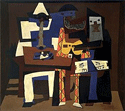Cubism Key Ideas
 Cubist artists abandoned perspective, which had been used to depict space since the Renaissance, and they also turned away from the realistic modeling of figures.
Cubist artists abandoned perspective, which had been used to depict space since the Renaissance, and they also turned away from the realistic modeling of figures.
CHANGING EXPERIENCE OF SPACE, MOVEMENT, AND TIME IN THE MODERN WORLD
Cubists explored open form, piercing figures and objects by letting the space flow through them, blending background into foreground, and showing objects from various angles. Some historians have argued that these innovations represent a response to the changing experience of space, movement, and time in the modern world. This first phase of the movement was called Analytic Cubism.
ACUTELY AWARE OF CURRENT EVENTS
In the second phase of Cubism, Synthetic Cubists explored the use of non-art materials as abstract signs. Their use of newspaper would lead later historians to argue that, instead of being concerned above all with form, the artists were also acutely aware of current events, particularly WWI.
UNITY BETWEEN A DEPICTED SCENE AND THE SURFACE OF THE CANVAS
Cubism paved the way for non-representational art by putting new emphasis on the unity between a depicted scene and the surface of the canvas. These experiments would be taken up by the likes of Piet Mondrian, who continued to explore their use of the grid, abstract system of signs, and shallow space.
9 CUBISTS EVERY ARTIST SHOULD KNOW:
Pablo Picasso
Albert Gleizes
Georges Braque
Juan Gris
Jacques Lipchitz
Jean Metzinger
Robert de la Fresnay
Sonia Delaunay
Fernand Léger
Reference: The Art Story | https://www.theartstory.org/movement-cubism.htm


